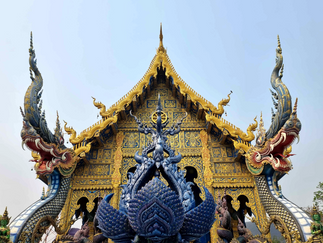Chiang Rai’s Blue Temple - Wat Rong Suea Ten
- Shannon
- Oct 13
- 3 min read
A Symphony of Colour and Devotion
Wat Rong Suea Ten rises from the northern landscapes of Chiang Rai like a shard of sapphire light, drawing the eye before the mind has even registered its meaning. Though constructed in 2005, the temple stands on a site that whispers of forgotten devotion, once home to an abandoned shrine where villagers believed the boundary between the mortal and spiritual worlds was thin. Today, the temple carries forward that energy, merging contemporary artistry with the timeless language of Buddhist symbolism, creating a space where the past and present seem to coexist in vibrant harmony.

The temple’s name, Rong Suea Ten, or “The Temple of the Dancing Tiger,” is rooted in a local legend. A mystical tiger is said to have once roamed the riverbanks nearby, leaping with such grace it seemed to dance. Villagers spoke of the tiger as a guardian spirit, its movements symbolising untamed power and freedom. Its presence is said to linger still, an invisible sentinel reminding all who enter that the path to enlightenment requires courage, balance and the ability to move with both strength and elegance.
Every surface of the temple is bathed in intense blue, chosen by local artist Phuttha Kabkaew to symbolise purity, wisdom and spiritual clarity. Along the edges, statues of Thewada (celestial attendants) stand with serene authority, bridging human devotion and divine presence. These figures are silent guides, embodying the protection and guidance that accompany those on a spiritual journey, their calm forms set against the vivid blues of walls that seem almost liquid in their intensity.

Inside the main hall, murals unfold like living scriptures, depicting samsara, the endless cycle of birth, death and rebirth. Yet the stories here are more than Buddhist teachings, they merge with Thai folklore, showing dragons, celestial serpents and hybrid creatures entwined with humans and spirits in moral tales. Each scene is layered with meaning, inviting the visitor to reflect on impermanence, karma and the delicate balance between the worldly and the divine, as if the walls themselves are whispering secrets of an age old spiritual landscape.
At the centre of the ubosot stands the 6 metre white Buddha, Rajamongkol Bodhi Trilokanat, whose gentle smile radiates calm and transcendence. His right hand rests in the Bhumisparsha Mudra, the Earth Witness Gesture, recalling the moment Siddhartha Gautama called upon the Earth to bear witness to his awakening. Legend holds that Phra Mae Thorani, the Earth Goddess, emerged from the ground, wringing torrents of water from her hair to wash away Mara’s armies of distraction and fear. This story echoes in the temple’s design, a reminder that awakening comes not through avoidance but through facing and transcending challenges.

Wat Rong Suea Ten embodies the history and culture of the Lanna Kingdom while embracing modern artistic expression. Every gilded detail and swirling motif is a meditation in miniature, inviting visitors to consider the intersection of material beauty and spiritual truth. Some who visit speak of a strange stillness, as if time itself has slowed within the temple walls and the spirit of the Dancing Tiger silently watches over all who enter.
More than a visual wonder, the Blue Temple functions as a centre for community and devotion. Locals gather for prayer and festivals, while travellers find quiet reflection among its vivid halls. The temple’s brilliance is not only aesthetic but also spiritual, drawing people into contemplation of life, folklore and the quest for enlightenment. Wat Rong Suea Ten is, in essence, a living testament to the merging of art, legend and devotion, a sanctuary where the ordinary and the mystical meet.

🗺️ Location
306 Moo 2, Maekok Road, Tambon Rim Kok, Mueang Chiang Rai District, Thailand
🚆 How to get there
The Blue Temple is located approximately 10km's north of Chiang Rai city centre and is easily accessible by taxi, tuk-tuk or scooter. For those exploring the area, it's often included in guided temple tours alongside other notable sites like the White Temple and Black House Museum.
⭐ Attraction Info
Wat Rong Suea Ten is open daily between 7am - 8pm, giving visitors ample time to admire its striking architecture and serene atmosphere. Admission is free, though donations are appreciated to help support the temple’s upkeep and ongoing artistic projects. Visitors are expected to dress modestly, typically covering shoulders and knees as a sign of respect for the sacred space and sarongs are available for purchase or rental onsite if needed. While the temple’s main hall is relatively compact, most visitors spend about 30 to 45 minutes exploring its intricate details and vibrant murals.



































